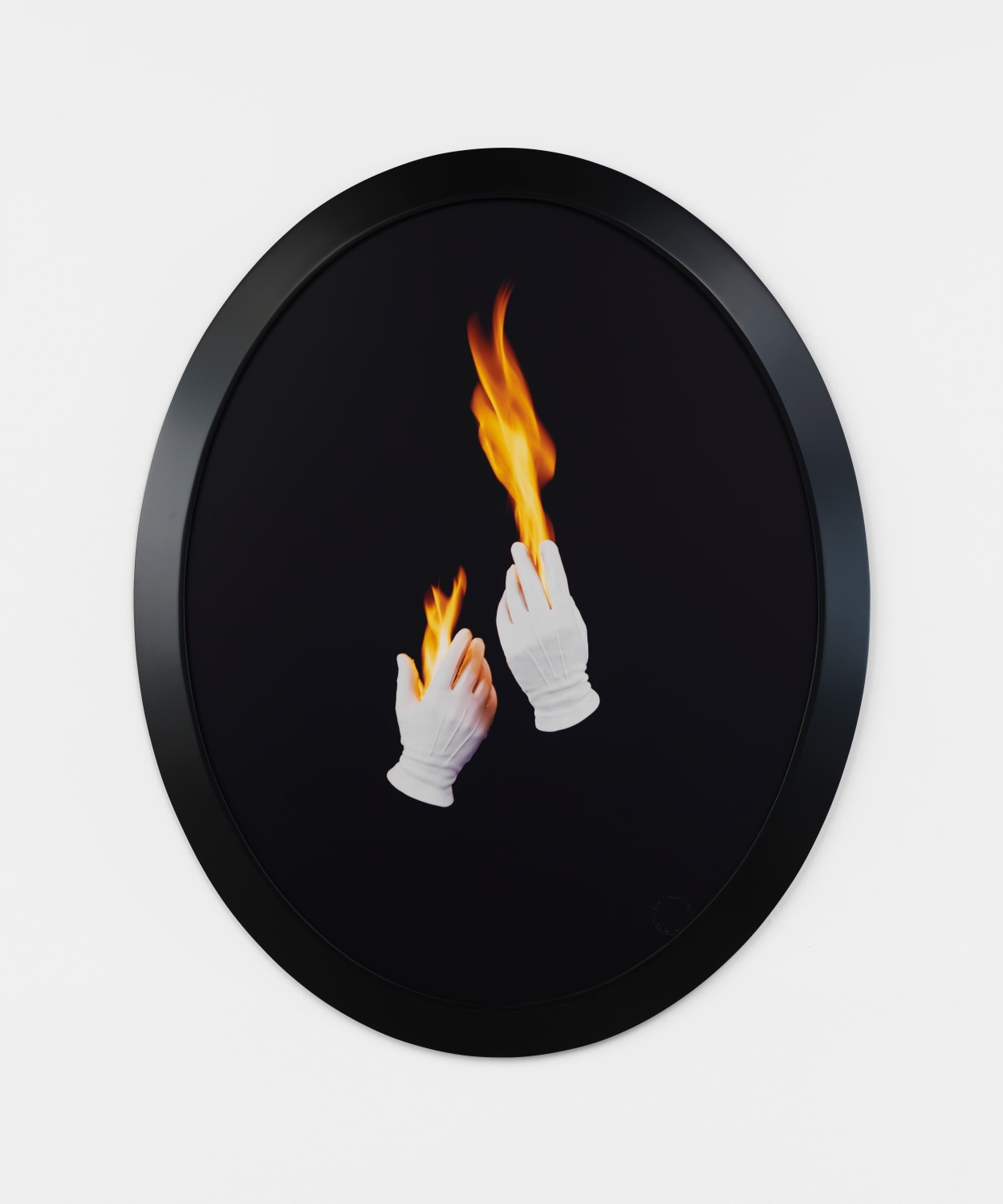
Sarah Charlesworth, Trial by Fire, 1992-93, Cibachrome with lacquered wood frame, 41 1/2 x 33 1/2 x 1 3/4 in. (105.4 x 85.1 x 4.4 cm). © The Estate of Sarah Charlesworth. Courtesy Paula Cooper Gallery, New York. Photo: Steven Probert
The eighteen pictures in ‘Desire and Seduction’ reside in a brainy technicolor universe. Meticulously composed in studio or extracted pre-photoshop from print media, Sarah Charlesworth’s subjects are isolated like Warhol’s ‘Gold Marilyn’ (1962) in shadowless voids of red or black (with several exceptions) and are either drained of affect or project nothing but: a picture of fire (‘Fire’, 2002) is a picture of fire while a geisha’s face (‘Red Mask’, 1983) is an unreadable cipher interchangeable here with a single lit candle or gold artifacts.
Charlesworth’s preference for the rich surface of Cibachrome paper (discontinued in 2011) and distinctive lacquered frames that matched the image’s background color give a sense of the work being both photo and object. As if to demonstrate Susan Sontag’s assertion that surrealism best mirrored the photograph’s alternative reality, five luxurious ovals host magic trick vignettes from what could be a seance attempting to contact Magritte. Among them a veiled sightless couple lean in (“Red Veils”, 1992-93), a handkerchief plummets (“Anti-Gravity” 1992-93) and a pair of white gloved hands miraculously survives a judgement of flame in ‘Trail by Fire” (1992-93).
For a deep dive into all things Sarah Charlesworth (1947-2013) the booklet accompanying last fall’s ‘Tabula Rasa’ exhibition at Paula Cooper Gallery is recommended. A granular read, the hefty publication channels the frugal copy shop aesthetic of 60’s conceptual art. Reviews, essays, press releases and ephemera are woven around the philosophical and political foundations of conceptualism and writings and reminiscences by Joseph Kosuth, Laurie Simmons, and James Welling. As a prodigy among an earlier version of this milieu, Charlesworth exhibited in important European galleries and contributed to now mythic publications including The Fox, Semiotexte, and BOMB which she co-founded. Bridging these decades is her important ‘Movie-Television-News-History, June 21, 1979’ (1979) that displayed 27 different newspaper front pages stripped of all text and thus the photographs as random signs untethered to meaning.
Charlesworth and her generation grew up in the ‘Madmen’ age of advertising and educated young artists in the 70’s attempted to deconstruct commercial media to better understand how it had formed them. Hardcore conceptualism’s puritanical revulsion to beauty, especially to illustrative color photography, would be diluted by tendencies which Charlesworth helped to pioneer including ‘narrative’ art that resembled conceptualism (images and text) but whose content could be recognized from the ‘real’ world. To compete with the lucrative handmade object in the mercantile 80’s Charlesworth and others expanded the size of the photographic print to a portable 30” x 40” and dropped the confining matting indicative of staid ‘fine art’ photography.
A diptych that juxtaposes a ghostly unoccupied ‘high fashion’ gown and an BDSM image in opposing black and red, ‘Figures’ (1983) is a post-modern touchstone. As in several other works both body’s forms are described in absentia only by the material that decorate or seal them. One is reminded of a generational adjacency to Robert Mapplethorpe, another fearless orchestrator of demonic and beautiful images. None of the desires we project into Sarah Charlesworth’s photographs go unexamined, a masterclass in the semiotics of looking. ‘Figures’ original intentions, along with that of the entire show, remain intact, even topical. A casual AI search into the meaning of the colors ‘red’ and ‘black’ came back with the semaphore signal code for ‘emergency’.
Tim Maul is an artist and art writer working in New York and Connecticut. His most recent publication is AFTERMATH, a collaboration with the Irish poet Catherine Morris, and published by Spring Publications.
—Tim Maul